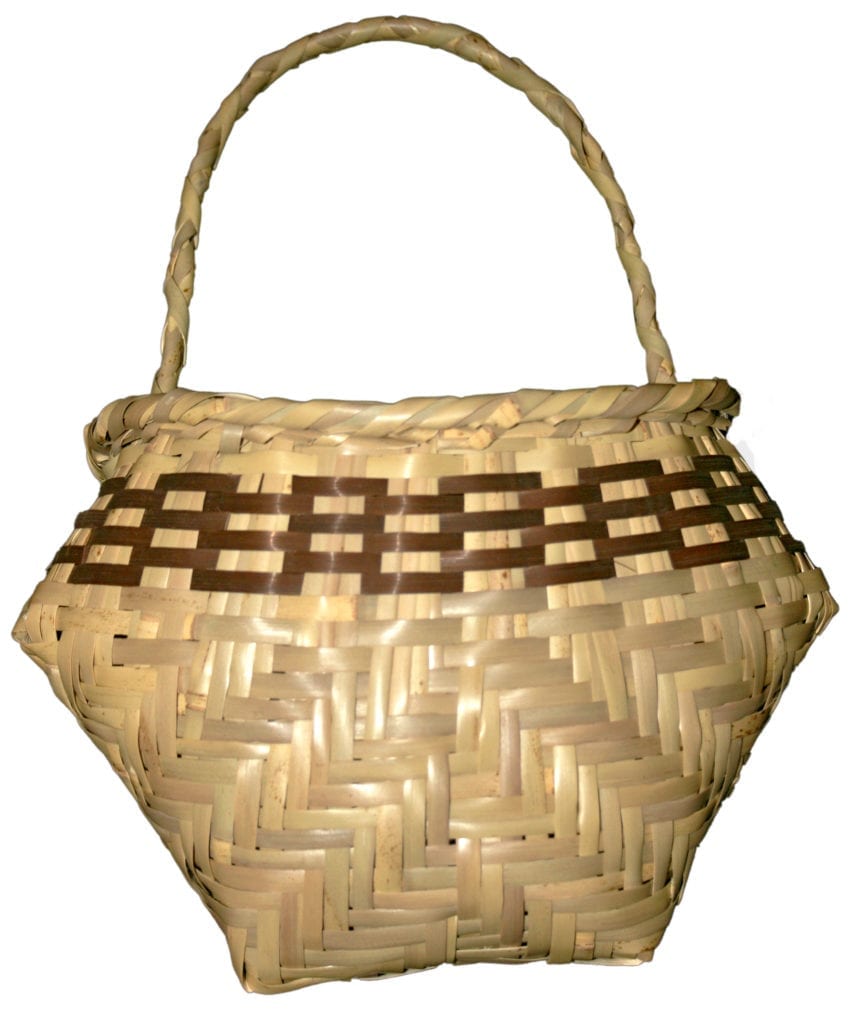
Covered in heavy clothing and donning boots, Eveline Battiest Steele trudges through dense cane breaks, where waist-high poison ivy and critters sometimes dog her efforts in finding something she covets.
Steele and her husband make periodic 60- to 80-mile round trips from their Broken Bow home to find mature cane along southeastern Oklahoma’s river banks. This type of cane can’t be bought, so Steele harvests the cane herself with branch cutters to weave traditional Choctaw baskets.
“One harvest makes maybe a couple of baskets, depending on basket size,” she says. “I only gather 25 to 30 cane poles because I only have a two-week window of time before they become dry and hard. At home, I use butcher knives to split the cane and peel it, making strands of cane fibers. Working eight to 10 hours a day, it takes a couple of weeks to prepare the cane and dye it.”
Steele creates natural dyes – black walnuts for black, brown and tan; bois d’ arc tree fruit, often called horse apples, for a color she calls Osage orange; and cochineal, a cactus parasite, for red.
“I take the item and put it in a liquid dye bath,” she says. “You can put your cane fibers in also. How long you keep it in the bath depends on the color shade you want. Then the actual weaving process only takes three to seven days, with a full turn-around time of three weeks to a month to produce one basket.

“I can’t keep up with the orders.”
Born in her parents’ home near Broken Bow, Steele and her family had no running water or electricity until she was 13. Steele’s first language is Choctaw, and she and her husband live about two miles from her birthplace.
Steele, whose ancestors came from Mississippi and Louisiana into Indian Territory, says no Choctaw basket weavers lived in the area for a long time. Then there were three, including her mother, Elsie Williams Battiest, who became famous as the longest-living weaver from that original group.
Battiest, born in 1914 in the community of Kuli Tuklo (Choctaw for “two wells or springs”), was the daughter of Fannie Battiest Williams Wesley, born around 1877 and whom Steele calls pokni (Choctaw for grandmother). These master weavers, using only traditional processes, taught Steele their craft.
Wesley continued basket weaving even after going blind. Her baskets are displayed at Tulsa’s Philbrook Museum and elsewhere across the country.
Steele taught her sons to make baskets. Kevin lives in Arizona, where there is no cane, and he is rarely in Oklahoma; however, Corey marks the fourth generation of the family to weave baskets.
In 2011, Steele demonstrated basket weaving at the Smithsonian National Museum of the American Indian in Washington. Her baskets appear at various locations and will be permanently shown in the Choctaw Nation Capitol Museum in Tvshka Homma (often anglicized as Tuskahoma). Steele’s baskets, along with a video showing the art process, will also remain on display at Durant’s soon-to-open Choctaw cultural center, named Chahta Nowvt Aya, or Choctaw Journey.
Steele also sews traditional ceremonial clothing and helps the tribe preserve and pass along the Choctaw language and the making of traditional baskets.

























